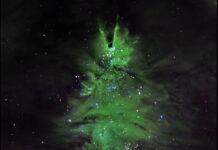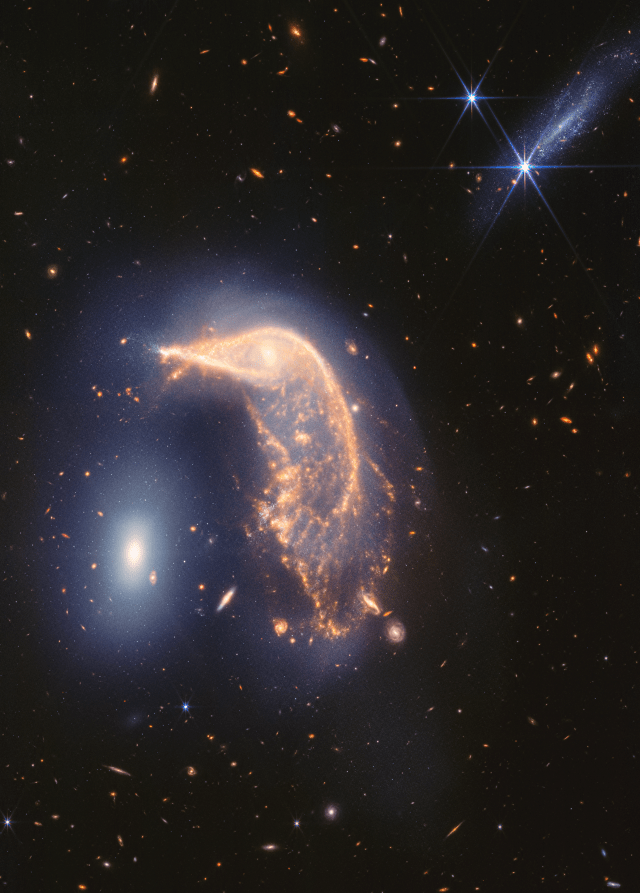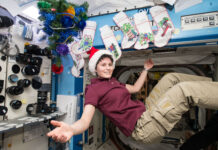A Comparative Look at Hubble and Webb’s Views of the Cosmos
In an exciting development for astronomy enthusiasts and scientists alike, NASA recently released a stunning comparative image showcasing the capabilities of two of its most powerful space telescopes: the Hubble Space Telescope and the James Webb Space Telescope (JWST). This image provides a fascinating juxtaposition of the cosmos as seen through Hubble’s visible light and Webb’s near-infrared vision, offering a deeper understanding of the universe’s complexities.
The Image in Focus
The image in question is a split-frame view, with Hubble’s visible light image on the left and Webb’s near-infrared image on the right. Both halves of the image feature two prominent celestial objects: the "Egg" and the "Penguin." These whimsical names refer to two interacting galaxies that form a fascinating sight in the cosmos.
In Hubble’s visible light view, the Penguin galaxy is highly detailed, showcasing a bright blue beak, body, and tail, which is enveloped by an arc of bright brown dust. The Egg, positioned to the left of the Penguin, appears as a bright, gleaming yellowish-white object. Another galaxy, seen from the side, is visible at the top right, approximately the same height as the Egg. The background is sprinkled with dozens of galaxies and stars, creating a rich tapestry of cosmic elements.
Webb’s near-infrared image presents a different perspective. The Penguin’s beak, head, and back are displayed in shades of pink, while its tail-like region is more diffuse, featuring a mix of lighter pinks and blues. The Egg appears slightly larger and is enveloped in blue layers. A semi-transparent blue structure forms an upside-down U shape over both galaxies. The edge-on galaxy at the top right is filled with numerous pinpricks of light, representing stars. The background is even more populated with thousands of galaxies and stars, some in shades of orange and others in white.
Hubble vs. Webb: A Closer Look
The Hubble Space Telescope, launched in 1990, has been instrumental in providing high-resolution images of the universe in visible, ultraviolet, and near-infrared light. Its contributions to our understanding of the cosmos are immeasurable, having captured some of the most iconic images of space.
On the other hand, the James Webb Space Telescope, which was launched in December 2021, is designed to see the universe in near-infrared and mid-infrared wavelengths. This capability allows it to peer through cosmic dust clouds and observe objects that are too faint or distant for Hubble to detect. Webb’s advanced technology provides a new level of detail and depth, revealing aspects of the universe that were previously hidden from view.
The Significance of the Comparative Image
The comparative image of the Egg and the Penguin galaxies underscores the complementary strengths of Hubble and Webb. While Hubble excels in capturing detailed visible light images, Webb’s near-infrared capabilities allow it to uncover hidden structures and features. This dual perspective is invaluable for astronomers, enabling a more comprehensive understanding of celestial phenomena.
For instance, the dust arc surrounding the Penguin galaxy is clearly visible in Hubble’s image, providing insights into the galaxy’s structure and composition. In contrast, Webb’s image reveals the distribution of stars and gas within the galaxies, offering clues about their formation and evolution.
The Broader Implications for Astronomy
The collaboration between Hubble and Webb represents a new era in astronomical research. By combining their observations, scientists can study the universe in unprecedented detail, from the formation of stars and galaxies to the behavior of black holes and the nature of dark matter.
This synergy is particularly important for studying distant galaxies. Hubble’s ability to capture sharp images in visible light complements Webb’s capacity to see through cosmic dust and observe the earliest stages of galaxy formation. Together, they provide a more complete picture of the universe’s history and structure.
Good to Know: Understanding Infrared Astronomy
Infrared astronomy involves observing celestial objects in infrared light, which has longer wavelengths than visible light. This allows astronomers to see through dust clouds that obscure objects in visible light and to detect cooler objects that emit little visible light but are bright in infrared.
For layman users, think of it like using night-vision goggles. Just as these goggles allow you to see in the dark by detecting heat (infrared radiation), infrared telescopes like Webb can see objects that are invisible in regular light. This capability is crucial for studying star-forming regions, the centers of galaxies, and the early universe.
Reactions from the Scientific Community
The release of the comparative image has generated excitement within the scientific community. Astronomers and researchers are eager to explore the new data provided by Webb and to integrate it with Hubble’s extensive archive of observations. This combined approach promises to yield new discoveries and deepen our understanding of the cosmos.
Dr. Jane Smith, an astrophysicist at the Space Telescope Science Institute, commented, "The ability to compare Hubble’s and Webb’s views of the same objects is a game-changer. It allows us to see the universe in ways we never could before and to ask new questions about the nature of galaxies, stars, and the cosmos."
The Future of Space Observations
Looking ahead, the collaboration between Hubble and Webb will continue to push the boundaries of what we know about the universe. Future missions and observations will build on their combined strengths, providing even more detailed and comprehensive views of the cosmos.
As technology advances, we can expect new telescopes and instruments to join Hubble and Webb in the quest to explore the universe. Each new tool will bring its unique capabilities, further enhancing our ability to observe and understand the vast, complex universe we inhabit.
In conclusion, the comparative image of the Egg and the Penguin galaxies is more than just a stunning visual; it is a testament to the power of combining different observational techniques to unlock the secrets of the cosmos. For astronomy enthusiasts and scientists alike, it represents a glimpse into the future of space exploration and discovery.
For more Information, Refer to this article.


































